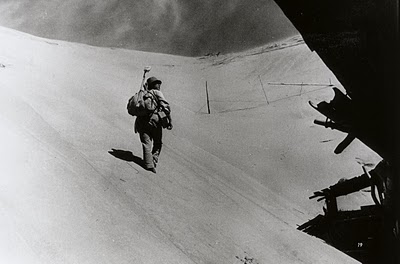On Southwest Airlines, which used to have hostesses in hot pants.
You are currently browsing the archive for the Videos category.
Never happened. (Thanks Live Leak.)
I interviewed Tom Waits once and he was every bit the great guy I had hoped. From Vulture, some of his comments upon being inducted into the Rock and Roll Hall of Fame: “This is just like the piano my mom got me. She couldn’t afford it, but she threw a brick through a window and got that piano. She only got seven years for it. She was a good mom, from jail.”
Tags: Tom Waits
AT&T industrial film made in 1976, slightly revised in 1980. Helped tide Shatner over until the T.J. Hooker paychecks started rolling in. (Thanks Endgadget.)
Tags: William Shatner

"The swindler was young and had a sandy mustache. He admired the vendor's pears and ordered him to put up two dozen."
If you wanted to witness mayhem during the 1890s in New York, all you had to do was stand near a street vendor and a crime wave was sure to develop. Five brief articles from the Brooklyn Daily Eagle illustrate this point.
••••••••••
“A Weight as a Weapon” (September 21, 1896): “Judel Cohen, the proprietor of a fruit store at 449 Rockaway avenue, was found guilty of an assault on Herman Masyr this morning. Masyr is the driver of a baker’s cart for George Geisler at 451 Rockaway avenue, next door to Cohen’s place. On August 31, about 3 o’clock in the afternoon Masyr drove his cart up to the front of the bakery. Cohen is also the possessor of a vendor’s stand and it was standing in front of his place loaded with fruit. The horse which Masyr drove selected the choicest of the fruit and began to feed. An argument followed and Cohen retreated to his store, where he picked up a pound weight. Returning to the front of the place he threw this at Masyr with such good aim that it stretched him unconscious on the sidewalk. Cohen fled and Masyr was put in the hands of an ambulance surgeon who sewed up the wound. Cohen stayed out of New York until yesterday, when he thought the affair had time to blow over. He was arrested at his store last night. Judge Harriman decided that he was guilty but suspended sentence.”
••••••••••
“An Italian Brained with a Shovel” (May 24, 1894): “Felice Pienzi, an Italian fruit vendor, had his skull fractured by the blow of a shovel wielded by Frank Lense, also an Italian, living in the same house with Pienzi at 155 Twenty-fifth street, this morning. The two men quarreled over a trifling money matter. The injured man was taken to the Seney hospital. His assailant followed him to the hospital in charge of an officer for identification. Pienze cannot recover.”
••••••••••
“He Lost His Temper” (November 1, 1891): “An Italian chestnut vendor named John Gamma, living at 45 New Bowery, New York, was held for trial in Essex Market police court by Police Justice Ryan, on a charge of stabbing. Gamma keeps his chestnut stall at the corner of Avenue C and Fifth street. Of late he has been greatly annoyed by a number of small boys assembled round his stand. On this day they began teasing him. The young Italian became infuriated and drawing an ugly looking pocket knife, stabbed one of the tormentors named Jacob Morris, 12 years of age, of 58 Avenue C, in the left arm, inflicting a slight injury.”
••••••••••
“Assaulted a Greek” (March 15, 1898): “Petro Paizalos, a Greek peanut vendor of 923 Atlantic avenue, charged John Dolan of 92 Bergen street, and John F. Fitzgerald of 68 Bergen street, with assault in the Flatbush court this morning. Both prisoners were held by Magistrate Steers for the Court of Special Sessions. A week ago the complainant, in company with another vendor, were walking on Clinton avenue when the two defendants, riding in an express wagon, are said to have attempted to run down Paizalos. A fight followed, in which Dolan is alleged to have struck the Greek with an iron bar, while Fitzgerald struck him with a brick.”
••••••••••
“The Fruit Man Was Swindled” (July 29, 1893): “An Italian fruit vendor who was stopped, to his loss, for a minute or two last night in front of the municipal building, was a victim of a clever but petty confidence man. The swindler was young and had a sandy mustache. He admired the vendor’s pears and ordered him to put up two dozen.
Then he asked the peddler to give him change for a two dollar bill minus the price of the pears, and disappeared with the cash and the fruit, saying that he would return in a minute with the two dollar bill. He left he vendor at the Joralemon street entrance and disappeared through the rear door leading to Livingston street, taking the pears and the change with him. Several headquarters detectives, who unconsciously witnessed the transaction, failed to find any trace of the swindler when wanted by the peddler.
••••••••••
Fruit vendors, Lower East Side, 1903:
Opening of John Donvan and Caren Zucker’s excellent 2010 Atlantic article about 77-year-old Donald Gray Triplett, the first person to ever be diagnosed with autism:
“IN 1951, A Hungarian-born psychologist, mind reader, and hypnotist named Franz Polgar was booked for a single night’s performance in a town called Forest, Mississippi, at the time a community of some 3,000 people and no hotel accommodations. Perhaps because of his social position—he went by Dr. Polgar, had appeared in Life magazine, and claimed (falsely) to have been Sigmund Freud’s ‘medical hypnotist’—Polgar was lodged at the home of one of Forest’s wealthiest and best-educated couples, who treated the esteemed mentalist as their personal guest.
Polgar’s all-knowing, all-seeing act had been mesmerizing audiences in American towns large and small for several years. But that night it was his turn to be dazzled, when he met the couple’s older son, Donald, who was then 18. Oddly distant, uninterested in conversation, and awkward in his movements, Donald nevertheless possessed a few advanced faculties of his own, including a flawless ability to name musical notes as they were played on a piano and a genius for multiplying numbers in his head. Polgar tossed out ’87 times 23,’ and Donald, with his eyes closed and not a hint of hesitation, correctly answered ‘2,001.’
Indeed, Donald was something of a local legend. Even people in neighboring towns had heard of the Forest teenager who’d calculated the number of bricks in the facade of the high school—the very building in which Polgar would be performing—merely by glancing at it.” (Thanks Longform.)
••••••••••
Tags: Caren Zucker, Donald Gray Triplett, Franz Polgar, John Donvan
Early computer chess, among other cool stuff.
Wu Yang turns 70 this year. (Thanks Reddit.)
AI pioneer Marvin Minsky at MIT in ’68 showing his robotic arm, which was strong enough to lift an adult, gentle enough to hold a child.
Minsky discussing smart machines on Edge: “Like everyone else, I think most of the time. But mostly I think about thinking. How do people recognize things? How do we make our decisions? How do we get our new ideas? How do we learn from experience? Of course, I don’t think only about psychology. I like solving problems in other fields — engineering, mathematics, physics, and biology. But whenever a problem seems too hard, I start wondering why that problem seems so hard, and we’re back again to psychology! Of course, we all use familiar self-help techniques, such as asking, ‘Am I representing the problem in an unsuitable way,’ or ‘Am I trying to use an unsuitable method?’ However, another way is to ask, ‘How would I make a machine to solve that kind of problem?’
A century ago, there would have been no way even to start thinking about making smart machines. Today, though, there are lots of good ideas about this. The trouble is, almost no one has thought enough about how to put all those ideas together. That’s what I think about most of the time.”
Tags: Marvin Minsky
One of the most shocking episodes in the upside-down decade of the ’70s–or any decade in American history, really–was the kidnapping of heiress Patty Hearst by the Symbionese Liberation Army, a violent and radical outgrowth of the tortured anti-war movement of the ’60s. The nation shuddered for the shanghaied scion, but soon Hearst was a full-fledged member of the SLA, knocking over banks, cursing the “pigs” and being pursued by the FBI along with her new “friends.” Was she brainwashed? Was she a traitor? Was she a rich girl acting out? Rolling Stone looked for answers in a cover story for its October 23, 1975 issue. An excerpt:
“The next day Patty ate her meals in the car. Even standing in line at a McDonalds was a risk. Millions had seen her picture on the evening news and the cover of Newsweek or heard her soft, distinctive voice on radio broadcasts of the S.L.A. communiqués.
For most of the previous four months she had been cooped up inside. Her excursions outside twice had ended in gunfire. Now she was driving across country through an FBI dragnet that already had employed more agents than any other civilian case.
The strain of the past months was showing. To Patty the passing world was populated by an army of undercover agents. Once, as Jack showed up to ease past a construction site, she ducked and whispered in a half shriek: ‘did you see that guy? I know he’s a pig.’
‘C’mon, he’s a highway flagman. Don’t be so uptight.’
When Jack pulled in for gas she frequently demanded he speed away as an attendant approached. ‘I don’t like the way he looks,’ she’d explain. ‘He looks like a pig.’
Patty’s repeated reviling of ‘pigs’ soon lead to a discussion about the political criterion for such a classification. Patty took the position that a pig was anyone who did not give wholehearted support to the S.L.A. Jane Fonda and Tom Hayden, for instance, were pigs because they’d criticized the S.L.A. tactics. Patty sounded like what she was — a new convert to radical thinking,”
••••••••••
The trailer for the great documentary, Guerrilla: The Taking of Patty Hearst:
Tags: Patty Hearst
Not that they have snot. Not yet, anyway. (Thanks Singularity Hub.)
Rudoph Steingass’ invention never caught on, probably because of the loss of trunk space. (Thanks Live Leak.)
Tags: Rudolph Steingass
By Lithuanian sculptor Mindaugas Tendziagolskis.
Tags: Mindaugas Tendziagolskis
Some faces that actually became famous + worst hairpiece ever. (Thanks Found Footage Festival.)
Ransom Riggs: “When I tell people I collect snapshots, I usually get a blank stare. So I made this video to help explain why I love them.”
Tags: Ransom Riggs
At least he stopped loitering in airports. (Thanks Open Culture.)
Tags: Alain de Botton
One-hour look at pitcher Ferguson Jenkins during the 1972-1973 seasons.
From an article about Ferguson Jenkins in the February 19, 2011 Vancouver Sun: “Jenkins, who was born and raised in Chatham, Ont., was in Winnipeg on Friday for the local unveiling of the new 59-cent peel-and-stick stamp issued in his honour during Black History Month.
The stamp includes a present-day image of Jenkins, the only Canadian inducted into the National Baseball Hall of Fame in Cooperstown, New York, with a photograph in the background from a Sports Illustrated cover showing him in his pitching heyday.
‘This is humbling,’ Jenkins, who won 284 major league games, said.”
Tags: Ferguson Jenkins
Made in 1964. C-3PO’s moves on display in the first minute. (Thanks Reddit.)
A faithful telling of Kobo Abe’s novel about a Tokyo teacher and bug collector who is kidnapped by an entire village while vacationing in the desert, this Sisyphean drama by Hiroshi Teshigahara is the best kind of parable, one marked by nuance, ambivalence and immense strangeness.
An entomologist who is about to be squashed, Niki Jumpei (Eiji Okada) sojourns to the desert to try to locate a rare type of tiger beetle, hoping his accomplishment will get his name listed in a field guide. A world-weary soul who is worn by city life, the educator is only too happy to accept a stranger’s offer to lodge him with a local. As several villagers lower him into a sand pit with a rope ladder, Jumpei has no idea that he is descending into an arranged marriage with the woman (Kyôko Kishida) who inhabits the hut.
 The woman must spend hours every day digging her house out from under sand drifts or it will collapse and a chain reaction will claim every home in the very interdependent village. She needs help with the chore since her husband recently died, so the neighbors decided to “trap” her a new husband. Soon realizing that the rope ladder will not be making a return appearance but unwilling to accept his fate, Jumpei hatches a succession of plots aimed at escaping from the pit. As each hope dries up, he increasingly unleashes his frustrations on the woman. But as the months progress, he begins to wonder whether the hopelessness of his new life is better than the frustration of his old one.
The woman must spend hours every day digging her house out from under sand drifts or it will collapse and a chain reaction will claim every home in the very interdependent village. She needs help with the chore since her husband recently died, so the neighbors decided to “trap” her a new husband. Soon realizing that the rope ladder will not be making a return appearance but unwilling to accept his fate, Jumpei hatches a succession of plots aimed at escaping from the pit. As each hope dries up, he increasingly unleashes his frustrations on the woman. But as the months progress, he begins to wonder whether the hopelessness of his new life is better than the frustration of his old one.
Of course, Jumpei doesn’t really have much of a choice in the matter. He will be made to sacrifice self for the greater good, to conform to the collective will to help ensure the survival of the community, to become one more fungible grain on the desert floor. He will all but disappear into the swarm. “If it wanted to,” the displaced man says with alarm, “the sand could swallow up cities…even entire countries.” It does all the time.•
Tags: Eiji Okada, Hiroshi Teshigahara, Kobo Abe, Kyôko Kishida
He is IBM engineer David Bradley, and he is be-boppin’ and skattin’ all over Bill Gates. (Thanks Reddit.)
Tags: Bill Gates, David Bradley
Lots of suds.
1972 footage of Elvis, already pretty much ruined, five years before dying.
______________________________
“He was all alone…in a long decline…thinking how lucky John Henry was that he fell down dyin’.”
Tags: Elvis Presley, Gillian Welch, John Henry
Time is on your side, puppy. (Thanks Reddit.)




